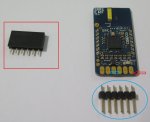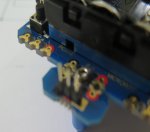If you look at page 5 of the RFA30 datasheet (here:
http://www.rev-ed.co.uk/docs/RFA020.pdf ) then there is a wiring diagram that shows how to connect the ERF module to a Picaxe. The same applies to connecting to the Picaxe on the Microbot, but you would need to solder wires to the correct places, and there may well not be provision to do that, so you may need to improvise. I don't have any photos of an ERF wired for programming, as I've only used the ERF as a data link, using 2 ERF modules with a Picaxe at either end, the same way that I'm now using the HC-12 modules.
The special Rev Ed ERF/URF combination was designed to be a way to programme without the need for a serial cable, which can be useful. The key difference between the ERF as supplied by Rev Ed, and the ERF as sold by Ciseco, was that the Rev Ed version has special internal programming that allows it to support the "break" function. The "break" function isn't a command, as such, it is an old RS232 method of signalling a transmission break, and consists of holding the Tx line at a logical 0 for longer than a single byte transmission frame. Normally a byte would be transmitted as a start bit, the data bits, plus a stop bit, and possibly a parity bit and more than one stop bit. The "break" signal just holds the Tx line at a logical 0 for longer than that duration, a duration that varies with baud rate and the specific data transmission format. The HC-12 (or HC-11) modules don't have the capability to do this, they can only transmit "regular" data frames, and cannot hold the Tx line at a logical 0 on command. As far as I know, there aren't any other serial wireless modules that support the "break" function, either.
I'm not sure what went on with Ciseco. They were a small start-up company, developing products for the "Internet of Things", that were bought out, then seems to have folded. I'm guessing they produced a batch of special ERF modules for Rev Ed and that when that stock runs out they will no longer be available. Rev Ed is also a very small company, and is focussed primarily on the educational market, so I doubt they would have been either able, or interested in, buying a company that was specialising in wireless connectivity.
Thanks for the offer of help with the Chinese translations. It is a problem that is commonplace, in that the data sheets for some Chinese-made modules are often poorly translated or almost non-existent. A good example is the HC-12 module, but in that case Robert Rozee has managed to write both a useful programming utility and edit the data sheet into more meaningful English (here:
https://github.com/robert-rozee?tab=repositories ). I'm in the process of translating a difficult to understand data sheet for a serial interface relay module, where the Chinese to English translation was not clear. One example that had me fooled for an hour or so was the term "crawl", applied to the logic state of a connection. I eventually found that was was really meant was that the relay would follow the logic state, with a logic 1 being open and logic 0 being closed. Similarly, the normal English term for changing the state of a pin sequentially is to toggle it. In the Chinese translation I had instead of toggle they had used the word "turn", or "turn over".



